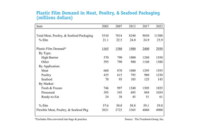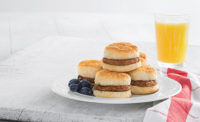Tech | Packaging
Advancing deli and lunchmeat packaging meets market demands and consumer needs

New packaging in the deli and lunchmeat category often is being driven by consumers’ lifestyle needs. For example, portable protein packs were created because consumers want to be fit and eat less while on the go. The smaller packaging also had to deliver divided compartments, because moist deli meat couldn’t be housed directly with a dry nut and then sealed to extend shelf life.
“Packaging has needed to be modified based on what we want to offer,” explains Eva Almenar, associate professor in the School of Packaging at Michigan State University, in East Lansing.
Processors also are starting to use paper more in order to present the product oftentimes to be perceived as more environmentally friendly.
“This market was not using paper before; however, now they are using it as a selling point since you still need the plastic in order to extend shelf life,” Almenar says.
Many lunchmeat packages use a closeable tray with a lid to allow a consumer to keep the product once it’s been opened the first time. The tray is often the secondary packaging in many cases, as the lunchmeat is packaged in thinner plastic inside the tray.
The industry is moving toward decreasing the amount of plastic used by keeping the bottom of the tray and using an easy-open and recloseable film for the lid. With more companies adopting sustainable practices, Almenar anticipates the category will continue to see a thinning of materials being used and the use of more films instead of trays. Companies also are reducing the size of the package to save materials.
In terms of packaging technologies, while the industry widely uses vacuum packaging, Almenar is seeing more modified atmosphere packaging used for some formats. Modified atmosphere packaging replaces air with gases that would be beneficial to extend product shelf life. For example, some products that use modified atmosphere technologies will include warnings that the product must be consumed within seven days of opening. That indicates a specific gas composition is leaving and the product starts deteriorating, Almenar says.
PACKAGING TO COME
With regard to the future, the pandemic has caused deli and lunchmeat sales through e-commerce to flourish. That growth is expected to continue after the pandemic.
“In that sense, we need to change our packages in order to make them more suitable for e-commerce, because that’s a totally different supply chain,” Almenar says.
Another big change for deli and lunchmeat packaging is the continued growth of clean-label products. With additives being removed from clean-label products, packaging must step up and do the job of extending shelf life, Almenar says.
Additionally, Almenar thinks more processors will use bio-based materials and, when possible, compostable or biodegrable products.
Almenar also expects active packaging will continue to grow in the lunchmeat category. Active packaging technology incorporates active compounds into the packaging material or within the packaging container so that the additives can interact directly with a perishable product and/or its environment to extend its quality and/or safety.
“That technology is growing in several food product areas, and I’m sure it will be in deli meats because in deli meats, you pay for a premium product,” Almenar says. “For that reason, I’m surprised that we don’t have that in every single package.”
In order to increase the communication between the company and consumer, Almenar also expects in the near future every package will be required to have a QR code or another product identification system. Product identification systems on packaging establish stronger connections between products and their farms, aid recalls or support e-commerce communication, Almenar says.
New printing technology being used on packaging globally has the ability to change color based on an alteration in product temperature or composition by breaking a modified atmosphere. For example, one packaging color communicates to a consumer the product is fresh and edible. Another color could inform the consumer the product is almost not edible. A third color could let the consumer know when the product isn’t edible.
Packaging innovation can be very challenging for processors because consumers don’t want to pay more, and advanced packaging designs and technologies can be expensive. Still, new packaging can reduce waste, increase safety and provide a fresher food.
“Consumer education plays a key role,” Almenar says. “We need to pay the price for a package that is going to deliver what we would like to have.” NP
FOR MORE INFORMATION ABOUT DELI MEAT PACKAGING, PLEASE VISIT THE FOLLOWING INDUSTRY SUPPLIERS:
Bunzl Processor Division/Koch Supplies — www.bunzlpd.com
Flair Packaging — www.flairpackaging.com
Hovus — www.hovus.com
Middleby Food Processing — www.middprocessing.com
Multivac — www.multivac.com
Progressive Packaging Inc. — www.progressivepackaging.com
Reiser — www.reiser.com
Sealed Air — www.sealedair.com
Ultrasource — www.ultrasourceusa.com
VC999/XtraPlast — home.vc999.com/en/
Looking for a reprint of this article?
From high-res PDFs to custom plaques, order your copy today!









